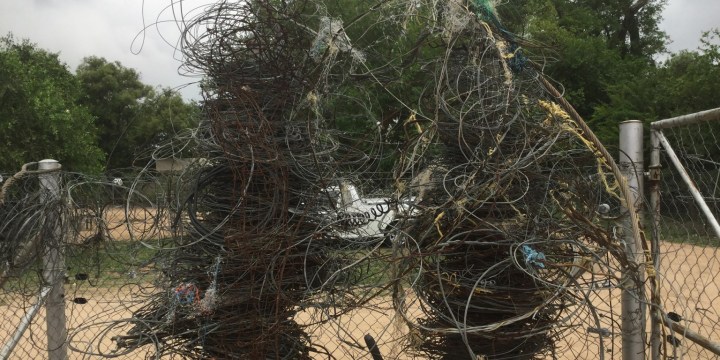WILDLIFE WOES
Snaring in Kruger National Park spikes more than 200% amid socioeconomic crisis

Since 2020, snaring has tripled in the crown jewels of South Africa’s Big Five reserves. This suggests economic hardship, although it is not the sole factor to blame.
Snared wildlife is the last thing tourists pay to see from their safari vehicle, yet an emerging onslaught in this crude form of poaching is set to become another concern for a country seeking to revamp its ecotourism reputation.
Recognised for its megadiversity, South Africa has introduced a new draft policy to overhaul the use of its iconic lions, leopards, elephants and rhinos. Open for a 30-day comment window from 19 September, the draft admits it is a grand reputation-management exercise. Among others, it aims to promote sustainable use; and end the controversial practice of keeping captive lions cruelly shot at close range.
However, new details in an internal question paper from Parliament’s National Assembly exposes a growing dilemma outside Kruger National Park. Affecting wildlife deep within the 2 million-hectare reserve, the trends suggest just how vulnerable many critters in this park are.
Responding to questions by the Democratic Alliance’s Hannah Winkler on the park’s snaring trends, Environment Minister Barbara Creecy reported the removal of thousands of snares:
- In 2020, 2,407 snares were removed;
- In 2021, 4,454 snares were removed;
- In 2022, 7,270 snares were removed.
That is a snaring uptick of more than 200% between 2020 and 2022, or a threefold increase of about 14,000 snares.
Two issues stand out. Firstly, the minister’s department has not yet issued statistics from 2023. Secondly, the data can only record known snaring incidents, so the predicament may be bigger than has been possible to present here.
Pandemic, poverty and poaching
When exploring the driving factors behind the onslaught, the conundrum deepens, because the available peer-reviewed data looks thin.
However, the chronology suggests a disquieting if still speculative correlation between the pandemic and snaring.
“No specific research has been undertaken to understand the primary drivers of snaring incidents,” the minister noted, “but we notice the increase coincides with the Covid-19 pandemic and increased poverty among communities adjacent to the Kruger Park.”
Though it may be difficult to believe this widely reported issue is under-researched, a 2022 University of Sussex study found most pandemic data on poaching in Southern Africa came from news media. These statistics were hard to gather, precisely because poaching was underground.
Either way, the minister’s explanation lends weight to wide-ranging reports and anecdotal evidence that have linked the pandemic’s socioeconomic ripple effects to a spike in poaching — and suggests an urgent need for more research.
That said, bushmeat is not the only reason the noose has tightened around Kruger’s species. The traditional medicine (muti) trade, retaliatory action against animals that clash with humans and internal corruption within the park may all compromise anti-poaching efforts.
Kruger National Park spokesperson Isaac Phaahla told Daily Maverick they had no empirical evidence that animal parts were used for muti; however, “some of the arrested people found with body parts are traditional healers”.
Snared on the boundary, found deep inside
The most afflicted regions were the Pafuri section, marking the park’s northern boundary, and western areas around Pretoriuskop, Stolsnek and Skukuza.
“Most snares are set along the boundaries of the park,” the minister further revealed. That is, they are “limited within a few kilometres from the perimeter boundary fence”.
Yet, even as the borders bore the brunt, snared animals were being found deeper within the park’s expanse, she explained.
Animals covered “vast distances” while trapped in snares, exposing them to profound pain and even death.
This method of hunting is problematic beyond the obvious harm to animals, because snares are indiscriminate — with the ability to inflict fatal suffering on non-target species.
Water sources — A life and death struggle
To make snares, poachers typically use wire or cord that is anchored to a fixed point, and shaped into a noose on animal paths.
Camouflaged to blend with the environment, these have triggers that tighten upon disturbance.
Placing snares seemed to follow a seasonal trend, the minister said, with more set up during drier months when animals gathered at specific watering points.
The very sources such as rivers or streams which are vital for species’ survival were turning into fatal traps, particularly those near boundaries and newly burnt areas.
The new internal question paper that shows the scale of the park’s snaring problem.
Minister: ‘All reports are actioned’
The park’s media desk said it was considering our detailed requests for immediate comment, but did not respond by the deadline at the weekend.
However, “various ongoing” programmes were aimed at removing snares in high-risk areas, the minister said. These included “regular patrols by field rangers, daily fence-monitoring patrols and specific snare-removal patrols carried out by South African National Parks (SANParks) honorary rangers”.
If snared or injured animals were found, they were reported to SANParks’ emergency hotline, “which operates 24/7”, she said.
“All reports are actioned” for the attention of the section ranger, the Veterinary Wildlife Services Unit, or state veterinary services, she added.
Kruger National Park spokesperson Phaahla said: “Kruger is surrounded by poverty-stricken communities where there is no service delivery, unemployment is very high and there is little or no law enforcement. That is the climate the park is operating in.”
Advocacy work was undertaken by their socioeconomic transformation team “to sensitise, educate and get commitment from communities to assist with the problem. Sophisticated criminal syndicates use intimidation, money and lack of law enforcement to carry out their nefarious acts.”
The park was building “key” partnerships with “relevant stakeholders including law enforcement agencies” in the hope of resolving the surge.
Wanted: $3-billion annually to protect lions alone
Endangered Wildlife Trust researcher Sam Nicholson told Daily Maverick that the country was a stronghold for some of Africa’s least sociopolitically fragile lions. The continent’s maned ambassador, however, largely roamed those countries in the bottom quarter of global wealth rankings.
This underscored the well-known fact that poverty pressures on wildlife, including lions, were not unique to South Africa.
Calling for $3-billion a year to save fenced and unfenced wild lions, the researcher and her co-authors recently published the first study to assess the social, political and ecological threats confronting this big cat across the continent.
Watch: Daily Maverick reporter Tiara Walters speaks to researcher Sam Nicholson about the updated cost of saving the continent’s wild lions.
The Nature-published study did not focus on snaring, instead highlighting multiple threats, but it did say that lions in Mozambique’s Limpopo National Park — right next to Kruger — were being driven to near-extinction due to increased poaching for lion parts. Bushmeat snaring likely caused local lion extinctions in Zambia’s Nsumbu National Park.
The authors have called on affluent nations to provide greater support to poorer countries with rich biodiversity.
“This research,” they argued, “underscores the moral responsibility of wealthier nations to contribute more significantly to lion conservation.”
To aid the complex task of protecting Kruger’s cherished diversity, from lions to leopard tortoises, solutions have been reported by Daily Maverick. These include ensuring enough trained rangers, more private-sector partners, and the goose that lays the golden egg: properly managed, sufficient funds.
Kruger’s snaring surge is a symptom of deeper fractures. And the call is not just for intervention — it is to recognise that the problem strikes at the heart of one of the world’s most significant wildlife economies. It is hard to imagine that South Africa can solve it alone. DM
This article was updated on 9 October at 7.21pm to reflect the comments from Isaac Phaahla, spokesperson for Kruger National Park.



















 Become an Insider
Become an Insider
Comments - Please login in order to comment.